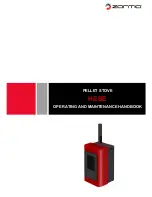
2
WARNING
It is prohibited to use gasoline, oil or other flammable liquids to light a fire
Never use your stove as an incinerator to burn great quantities of light fuels such as oil waste,
naphtha, and gasoline or engine oil. The fire might get out of control and may cause a chimney fire.
During combustion, the walls of the stove become very hot; do not touch them
Keep the door closed when the stove is in use because if you heat with the door open smoke can
be released (carbon monoxide) from your apparatus and can involve the loss of control of the flame
CREOSOTE
When wood burns slowly, it produces tar and other organic vapours when, associated with
moisture, forms creosote. The creosote vapour condenses in a chimney flue relatively cooled by a
slow fire. It results an accumulation of creosote inside the pipe.
When burning, the creosote forms an extremely blazing hot fire.
It is preferable to make small brisk fires rather than large smouldering fires. This will enable you to
keep the chimney and glass clean.
It is important to inspect the chimney or clean it periodically.
WOOD
Avoid using green wood to slow down combustion. This causes the formation of excessive soot and
creosote deposit in the chimney. It may cause a chimney fire. An accumulation of more than 3mm
of creosote is sufficient to proceed to the cleaning of the chimney in order to reduce the risks of a
chimney fire.
It is important to buy seasoned wood to obtain a better quantity of heat per wood cord.
Place reasonable loads do not overload the apparatus and ensure that the logs are placed in order
not to slam against the glass, or to burn too close to the glass.
Use seasoned wood only. Note that
6-12
months are needed for drying to have seasoned wood
and quality equivalent to
15 to 20 %
of moisture.
→
Important
: Do not store the wood near the stove
.
LIGHTING A FIRE
Lighting, a good sharp fire is necessary. Introduce into the outer firebox a small quantity of old
ruffled papers and cover them with seasoned kindling. Open the damper key (Located at the
center, behind the higher shutter) and light fire. As soon as fire is well taken, add pieces of wood a
little larger and close the door. When the stove is hot, do not touch the handle with bare hands.
At the beginning of lighting open the air register input (Lever located at the bottom of the ash
drawer) so that the air is not driven back in the stove, it is very important to foresee a good airflow
in the area.
The combustion controls were especially designed to allow an air intake of 10% when they are
completely closed.




































